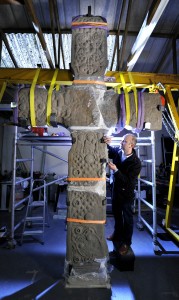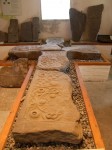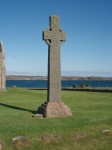 Historic Scotland is reassembling St. Oran’s Cross, one of the first (if not the first) Celtic High Cross ever made, so that it may be raised on the island of Iona in time for the 1450th anniversary of St. Columba’s arrival on the island and his founding of the monastery in 563 A.D. Built in the mid-8th century, the massive cross has been in five pieces for centuries. Before January 2012 when the reassembly project began, the pieces were on display on the floor, resting on their back at the Iona Abbey museum.
Historic Scotland is reassembling St. Oran’s Cross, one of the first (if not the first) Celtic High Cross ever made, so that it may be raised on the island of Iona in time for the 1450th anniversary of St. Columba’s arrival on the island and his founding of the monastery in 563 A.D. Built in the mid-8th century, the massive cross has been in five pieces for centuries. Before January 2012 when the reassembly project began, the pieces were on display on the floor, resting on their back at the Iona Abbey museum.
As of last year the broken pieces of St. Oran’s Cross were sent to Selkirk, Scotland, to the workshop of museum mount maker Richard West. He is creating a steel structure that will keep the cross pieces together upright so visitors can see the one-ton, 14.4-foot tall sculpture in all its imposing height as pilgrims to Iona saw it for hundreds of years. This isn’t just a nifty thing, but a historically significant display since the High Crosses were created in the tradition of pre-Christian standing stones and thus meant to inspire not only with their beautiful decoration, but with their sheer vertical massiveness.
 The cross was chiseled out of three large blocks of schist stones and was erected at the Reilig Òdhrain (Sr. Oran’s graveyard), the cemetery that would become known as the burial ground of at least seven early Scottish kings, plus kings of Ireland and Man and the chieftains of important Scottish clans in the later Middle Ages. The carved decorations are also fusions of the pre-Christian Celtic tradition and early Christian symbols. The spirals and vines, Celtic symbols of the intertwining of heaven and earth, were syncretized into Celtic Christianity, as were the snakes, whose shedding of their skin symbolized Christ’s resurrection. Rounded circles called bosses like the metalwork center of shields, are grouped into fives (the number of wounds Christ suffered) and arranged into cross shapes.
The cross was chiseled out of three large blocks of schist stones and was erected at the Reilig Òdhrain (Sr. Oran’s graveyard), the cemetery that would become known as the burial ground of at least seven early Scottish kings, plus kings of Ireland and Man and the chieftains of important Scottish clans in the later Middle Ages. The carved decorations are also fusions of the pre-Christian Celtic tradition and early Christian symbols. The spirals and vines, Celtic symbols of the intertwining of heaven and earth, were syncretized into Celtic Christianity, as were the snakes, whose shedding of their skin symbolized Christ’s resurrection. Rounded circles called bosses like the metalwork center of shields, are grouped into fives (the number of wounds Christ suffered) and arranged into cross shapes.
These designs dovetail seamlessly with more explicitly Christian iconography, like the image of Daniel in the Lion’s Den on the left cross-arm. Most notably, in the center underneath the cross arm is an image of the Virgin Mary holding the infant Christ flanked by angels on either side. This is one of the earliest images of Virgin and Child known.
 Quarrying the stone, transporting it, carving it, putting it together would have been an exceptionally expensive proposition. Although the carvings are faded now after centuries in the elements, their quality remains unmistakable. The best in the business made this cross. Historic Scotland experts believe it had to have been commissioned by a king since nobody else could have mustered the funds and manpower to make it happen. A likely candidate is Óengus son of Fergus king of the Picts, who conquered Iona around 741 A.D.
Quarrying the stone, transporting it, carving it, putting it together would have been an exceptionally expensive proposition. Although the carvings are faded now after centuries in the elements, their quality remains unmistakable. The best in the business made this cross. Historic Scotland experts believe it had to have been commissioned by a king since nobody else could have mustered the funds and manpower to make it happen. A likely candidate is Óengus son of Fergus king of the Picts, who conquered Iona around 741 A.D.
The cross underscores the religious and political significance of Iona in early Christian and medieval Scotland. St. Columba is credited with bringing Christianity to Scotland. We don’t know how much converting he personally did, but the abbey he founded, his relics, the High Crosses made the island a sacred place and site of pilgrimage. Its importance was undiminished until the Protestant Reformation which ended monastic life on the island and ushered in a long era of neglect, hence the decay of three  of the four High Crosses (only St. Martin’s remains intact, upright and in its original position).
of the four High Crosses (only St. Martin’s remains intact, upright and in its original position).
It was a challenge creating the steel structure that would support the cross in its original posture, but moving it back to Iona is going to be an even greater challenge. The cradle and cross are huge and heavy. It will take two ferry trips and a walk across a field to get it to the museum, and then it will have to be squeezled into the building which isn’t exactly set up for giant freight intake. Once they manage to get it in the door, the final stages of cleaning, conservation and stabilization will take place at the museum.
Thank you, thank you for posting the story about this cherished relic, and for the information of syncretized Celtic iconography.
I can’t wait to see this restoration! I visited Iona last spring and it was one of the highlights of my year in Scotland. I highly recommend it – and if you go, try to stay for a couple of nights on the island rather than going back to the “mainland” of the Isle of Mull. There are many incredible high crosses and tomb slabs there, and the Abbey itself is quite an otherworldly experience. The entire island is one of the most peaceful places I’ve ever been, but the history (and historical importance) of Iona is quite remarkable.
Thanks for your personal marvelous posting!
I certainly enjoyed reading it, you may be a great author.
I will always bookmark your blog and will often come back in the
foreseeable future. I want to encourage continue
your great work, have a nice weekend!
I always relate the halo at the intersection of the bar with the Celtic Cross. I suppose this is really not an exclusive design among Celtic Crosses after all.